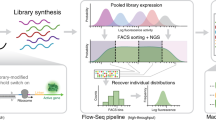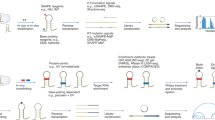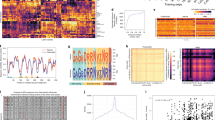Abstract
RNA engineering has immense potential to drive innovation in biotechnology and medicine. Despite its importance, a versatile platform for the automated design of functional RNA is still lacking. Here, we propose RNA family sequence generator (RfamGen), a deep generative model that designs RNA family sequences in a data-efficient manner by explicitly incorporating alignment and consensus secondary structure information. RfamGen can generate novel and functional RNA family sequences by sampling points from a semantically rich and continuous representation. We have experimentally demonstrated the versatility of RfamGen using diverse RNA families. Furthermore, we confirmed the high success rate of RfamGen in designing functional ribozymes through a quantitative massively parallel assay. Notably, RfamGen successfully generates artificial sequences with higher activity than natural sequences. Overall, RfamGen significantly improves our ability to design functional RNA and opens up new potential for generative RNA engineering in synthetic biology.
This is a preview of subscription content, access via your institution
Access options
Access Nature and 54 other Nature Portfolio journals
Get Nature+, our best-value online-access subscription
$29.99 / 30 days
cancel any time
Subscribe to this journal
Receive 12 print issues and online access
$259.00 per year
only $21.58 per issue
Buy this article
- Purchase on Springer Link
- Instant access to full article PDF
Prices may be subject to local taxes which are calculated during checkout





Similar content being viewed by others
Data availability
The sequence data of the massively parallel assay has been deposited in the Sequence Read Archive under accession code PRJNA1044007. All other data are provided in this paper. Source data are provided with this paper.
Code availability
The code of RfamGen and python custom scripts are disclosed on GitHub (https://github.com/Shunsuke-1994/rfamgen). Codes are also deposited on Zenodo (https://zenodo.org/doi/10.5281/zenodo.10187598)62.
References
Wilson, D. S. & Szostak, J. W. In vitro selection of functional nucleic acids. Annu. Rev. Biochem. 68, 611–647 (1999).
Guo, P. et al. Engineering RNA for targeted siRNA delivery and medical application. Adv. Drug Deliv. Rev. 62, 650–666 (2010).
Kim, C. M. & Smolke, C. D. Biomedical applications of RNA-based devices. Curr. Opin. Biomed. Eng. 4, 106–115 (2017).
Kim, J. & Franco, E. RNA nanotechnology in synthetic biology. Curr. Opin. Biotech. 63, 135–141 (2020).
Thavarajah, W., Hertz, L. M., Bushhouse, D. Z., Archuleta, C. M. & Lucks, J. B. RNA engineering for public health: innovations in RNA-based diagnostics and therapeutics. Annu. Rev. Chem. Biomol. 12, 263–286 (2021).
Dykstra, P. B., Kaplan, M. & Smolke, C. D. Engineering synthetic RNA devices for cell control. Nat. Rev. Genet. 23, 215–228 (2022).
Liang, J. C., Bloom, R. J. & Smolke, C. D. Engineering biological systems with synthetic RNA molecules. Mol. Cell 43, 915–926 (2011).
Qi, L. S. & Arkin, A. P. A versatile framework for microbial engineering using synthetic non-coding RNAs. Nat. Rev. Microbiol. 12, 341–354 (2014).
Etzel, M. & Mörl, M. Synthetic riboswitches: from plug and pray toward plug and play. Biochemistry 56, 1181–1198 (2017).
Kobori, S. & Yokobayashi, Y. Analyzing and tuning ribozyme activity by deep sequencing to modulate gene expression level in mammalian cells. ACS Synth. Biol. 7, 371–376 (2018).
Strobel, B. et al. High-throughput identification of synthetic riboswitches by barcode-free amplicon-sequencing in human cells. Nat. Commun. 11, 714 (2020).
Rotrattanadumrong, R. & Yokobayashi, Y. Experimental exploration of a ribozyme neutral network using evolutionary algorithm and deep learning. Nat. Commun. 13, 4847 (2022).
Dotu, I. et al. Complete RNA inverse folding: computational design of functional hammerhead ribozymes. Nucleic Acids Res. 42, 11752–11762 (2014).
Yamagami, R., Kayedkhordeh, M., Mathews, D. H. & Bevilacqua, P. C. Design of highly active double-pseudoknotted ribozymes: a combined computational and experimental study. Nucleic Acids Res. 47, gky1118 (2018).
Najeh, S., Zandi, K., Perreault, J. & Kharma, N. Computational design and experimental verification of pseudoknotted ribozymes. RNA https://doi.org/10.1261/rna.079148.122 (2023).
Eddy, S. R. & Durbin, R. RNA sequence analysis using covariance models. Nucleic Acids Res. 22, 2079–2088 (1994).
Durbin, R., Eddy, S. R., Krogh, A. & Mitchison, G. Biological Sequence Analysis: Probabilistic Models of Proteins and Nucleic Acids (Cambridge Univ. Press, 1998).
Kalvari, I. et al. Rfam 14: expanded coverage of metagenomic, viral and microRNA families. Nucleic Acids Res. 49, D192–D200 (2020).
Alley, E. C., Khimulya, G., Biswas, S., AlQuraishi, M. & Church, G. M. Unified rational protein engineering with sequence-based deep representation learning. Nat. Methods 16, 1315–1322 (2019).
Biswas, S., Khimulya, G., Alley, E. C., Esvelt, K. M. & Church, G. M. Low-N protein engineering with data-efficient deep learning. Nat. Methods 18, 389–396 (2021).
Iwano, N., Adachi, T., Aoki, K., Nakamura, Y. & Hamada, M. Generative aptamer discovery using RaptGen. Nat. Comput. Sci. 2, 378–386 (2022).
Iuchi, H. et al. Representation learning applications in biological sequence analysis. Comput. Struct. Biotechnol. J. 19, 3198–3208 (2021).
Gómez-Bombarelli, R. et al. Automatic chemical design using a data-driven continuous representation of molecules. ACS Cent. Sci. 4, 268–276 (2018).
Kingma, D. P. & Welling, M. Auto-encoding variational bayes. Proceedings of 2nd International Conference on Learning Representations (ICLR) (eds Bengio, Y. & LeCun, Y.) (2014).
Yao, Z., Weinberg, Z. & Ruzzo, W. L. CMfinder—a covariance model based RNA motif finding algorithm. Bioinformatics 22, 445–452 (2006).
Rivas, E. Evolutionary conservation of RNA sequence and structure. Wiley Interdiscip. Rev. RNA 12, e1649 (2021).
Nawrocki, E. P. & Eddy, S. R. Infernal 1.1: 100-fold faster RNA homology searches. Bioinformatics 29, 2933–2935 (2013).
Wilburn, G. W. & Eddy, S. R. Remote homology search with hidden Potts models. PLoS Comput. Biol. 16, e1008085 (2020).
Nawrocki, E. P. et al. Rfam 12.0: updates to the RNA families database. Nucleic Acids Res. 43, D130–D137 (2015).
Rivas, E., Clements, J. & Eddy, S. R. A statistical test for conserved RNA structure shows lack of evidence for structure in lncRNAs. Nat. Methods 14, 45–48 (2017).
Li, C., Qian, W., Maclean, C. J. & Zhang, J. The fitness landscape of a tRNA gene. Science 352, 837–840 (2016).
Weinberg, Z. et al. New classes of self-cleaving ribozymes revealed by comparative genomics analysis. Nat. Chem. Biol. 11, 606–610 (2015).
Li, S., Lünse, C. E., Harris, K. A. & Breaker, R. R. Biochemical analysis of hatchet self-cleaving ribozymes. RNA 21, 1845–1851 (2015).
Zheng, L. et al. Structure-based insights into self-cleavage by a four-way junctional twister-sister ribozyme. Nat. Commun. 8, 1180 (2017).
Andreasson, J. O., Savinov, A., Block, S. M. & Greenleaf, W. J. Comprehensive sequence-to-function mapping of cofactor-dependent RNA catalysis in the glmS ribozyme. Nat. Commun. 11, 1663 (2020).
Kobori, S., Nomura, Y., Miu, A. & Yokobayashi, Y. High-throughput assay and engineering of self-cleaving ribozymes by sequencing. Nucleic Acids Res. 43, e85–e85 (2015).
Kobori, S. & Yokobayashi, Y. High-throughput mutational analysis of a twister ribozyme. Angew. Chem. Int. Ed. 55, 10354–10357 (2016).
Xiang, J. S. et al. Massively parallel RNA device engineering in mammalian cells with RNA-Seq. Nat. Commun. 10, 4327 (2019).
Hopf, T. A. et al. Mutation effects predicted from sequence co-variation. Nat. Biotechnol. 35, 128–135 (2017).
Riesselman, A. J., Ingraham, J. B. & Marks, D. S. Deep generative models of genetic variation capture the effects of mutations. Nat. Methods 15, 816–822 (2018).
Townshend, B., Kennedy, A. B., Xiang, J. S. & Smolke, C. D. High-throughput cellular RNA device engineering. Nat. Methods 12, 989–994 (2015).
Im, D. J., Ahn, S., Memisevic, R. & Bengio, Y. Denoising criterion for variational auto-encoding framework. Proceedings of the AAAI Conference on Artificial Intelligence, Vol. 31 (2017).
Hawkins-Hooker, A. et al. Generating functional protein variants with variational autoencoders. PLoS Comput. Biol. 17, e1008736 (2021).
Trinquier, J., Uguzzoni, G., Pagnani, A., Zamponi, F. & Weigt, M. Efficient generative modeling of protein sequences using simple autoregressive models. Nat. Commun. 12, 5800 (2021).
Shin, J.-E. et al. Protein design and variant prediction using autoregressive generative models. Nat. Commun. 12, 2403 (2021).
Wang, J. et al. AAV-delivered suppressor tRNA overcomes a nonsense mutation in mice. Nature 604, 343–348 (2022).
Albers, S. et al. Engineered tRNAs suppress nonsense mutations in cells and in vivo. Nature 618, 842–848 (2023).
Kofman, C. et al. Computationally-guided design and selection of high performing ribosomal active site mutants. Nucleic Acids Res. 50, 13143–13154 (2022).
Krüger, A. et al. Community science designed ribosomes with beneficial phenotypes. Nat. Commun. 14, 961 (2023).
Ausländer, S. et al. A general design strategy for protein-responsive riboswitches in mammalian cells. Nat. Methods 11, 1154–1160 (2014).
Kusner, M. J., Paige, B. & Hernández-Lobato, J. Grammar variational autoencoder. Proceedings of the 34th International Conference on Machine Learning (ICML), Vol. 70. 1945–1954 (2017).
Kawano, S. et al. Tutorial videos of bioinformatics resources: online distribution trial in Japan named TogoTV. Brief. Bioinforma. 13.2, 258–268 (2012).
Janssen, S. & Giegerich, R. Ambivalent covariance models. BMC Bioinforma. 16, 178 (2015).
Fu, H. et al. Cyclical annealing schedule: a simple approach to mitigating KL vanishing. Proceedings of the 2019 Conference of the North American Chapter of the Association for Computational Linguistics (eds Burstein, J. et al.) 240–250 (ACL, 2019).
Rivas, E., Clements, J. & Eddy, S. R. Estimating the power of sequence covariation for detecting conserved RNA structure. Bioinformatics 36, 3072–3076 (2020).
Weinberg, Z. & Breaker, R. R. R2R—software to speed the depiction of aesthetic consensus RNA secondary structures. BMC Bioinforma. 12, 3 (2011).
McCarthy, T. J. et al. Ligand requirements for glmS ribozyme self-cleavage. Chem. Biol. 12, 1221–1226 (2005).
Behrens, A., Rodschinka, G. & Nedialkova, D. D. High-resolution quantitative profiling of tRNA abundance and modification status in eukaryotes by mim-tRNAseq. Mol. Cell 81, 1802–1815.e7 (2021).
Zhang, J., Kobert, K., Flouri, T. & Stamatakis, A. PEAR: a fast and accurate Illumina Paired-End reAd mergeR. Bioinformatics 30, 614–620 (2014).
Li, H. & Durbin, R. Fast and accurate short read alignment with Burrows–Wheeler transform. Bioinformatics 25, 1754–1760 (2009).
Bingham, E. et al. Pyro: deep universal probabilistic programming. J. Mach. Learn. Res. 20, 973–978 (2019).
Sumi, S. et al. rfamgen. Zenodo https://doi.org/10.5281/zenodo.10187598 (2023).
Acknowledgements
This work was supported by JST CREST (grant nos. JPMJCR21F1 and JPMJCR23B3) and JSPS (grant nos. 21J15897 and 20H05626). Computations were partially performed on the NIG supercomputer at the ROIS National Institute of Genetics. We thank C. Li, J. Zhang (University of Michigan) and Y. Yokobayashi (Okinawa Institute of Science and Technology) for providing DMS, K. Hui for proofreading the manuscript, R. K. Kawaguchi (Kyoto University), L. Maya (Imperial College London) and M. Hirosawa (Kyoto University) for reading the manuscript.
Author information
Authors and Affiliations
Contributions
S.S., M.H. and H.S. managed the project. S.S. conceived the idea, developed the RfamGen program and conducted all experiments. S.S., M.H. and H.S. wrote the manuscript.
Corresponding authors
Ethics declarations
Competing interests
S.S., M.H. and H.S. are the inventors of record listed on the patents (US Provisional Patent application no. 63/514389). H.S. owns shares in aceRNA Technologies Ltd and is an outside director of aceRNA Technologies Ltd.
Peer review
Peer review information
Nature Methods thanks Michael Mohsen and the other, anonymous, reviewer(s) for their contribution to the peer review of this work. Primary Handling Editor: Rita Strack, in collaboration with the Nature Methods team.
Additional information
Publisher’s note Springer Nature remains neutral with regard to jurisdictional claims in published maps and institutional affiliations.
Extended data
Extended Data Fig. 1 Architecture of RfamGen.
A sequence is represented as a triplet (tr, ss, bp). RfamGen is a variational autoencoder (VAE) trained to encode and decode triples while embedding them into the 16-dimensional latent space (z). Further details are described in the Supplementary Note.
Extended Data Fig. 2 Examples of semantics captured by latent space of RfamGen.
(a) t-SNE visualization of the latent space of RfamGen trained for RF00005 (tRNA) colored with phylogenetic information (top left) and anticodon information (top, right), RF00004 (U2 spliceosomal RNA, left bottom) and TPP riboswitch (RF00059, right bottom), colored with phylogenetic information. (b) t-SNE visualization of the latent space of RF00008 along with sequences with U1A protein binding motifs (UUGCAC in a loop) (top). Representative examples of the discovered sequences with high bit scores (bottom).
Extended Data Fig. 3 Evaluation of generated sequences by argmax and random sampling from a reconstructed CM.
(a) Computational procedure of evaluation of argmax and random sampling from a CM. Sequences were generated by argmax sampling (randomly sampled 1000 points from the latent space and then sampled 1 argmax sequence from 1 decoded CM) and random sampling (randomly sampled 1000 points from the latent space and then sampled 10 random sequences from 1 decoded CM). The sampled sequences were aligned to CM enrolled in Rfam database followed by bit score calculation. (b) Scatter plot of average bit scores of generated sequences of argmax and random sampling using 628 RNA families. (c) PAGE separation of cleavage products of glmS ribozymes generated by the two sampling methods from a CM (argmax and random sampling). A representative gel image from N = 3 replicates is shown. Arrowheads indicate cleaved products.
Supplementary information
Supplementary Information
Supplementary Note and Figs. 1–11.
Supplementary Table 1
Parameter of each experiment of RfamGen.
Supplementary Table 2
Oligos used in this research.
Source data
Source Data Fig. 2
The numerical and statistical source data of Fig. 2.
Source Data Fig. 3
The numerical and statistical source data of Fig. 3.
Source Data Fig. 4
The numerical and statistical source data of Fig. 4.
Source Data Fig. 5
The numerical and statistical source data of Fig. 5.
Source Data Extended Data Fig. 2
The numerical and statistical source data of Extended Data Fig. 2.
Source Data Extended Data Fig. 3
The numerical and statistical source data of Extended Data Fig. 3.
Rights and permissions
Springer Nature or its licensor (e.g. a society or other partner) holds exclusive rights to this article under a publishing agreement with the author(s) or other rightsholder(s); author self-archiving of the accepted manuscript version of this article is solely governed by the terms of such publishing agreement and applicable law.
About this article
Cite this article
Sumi, S., Hamada, M. & Saito, H. Deep generative design of RNA family sequences. Nat Methods 21, 435–443 (2024). https://doi.org/10.1038/s41592-023-02148-8
Received:
Accepted:
Published:
Issue Date:
DOI: https://doi.org/10.1038/s41592-023-02148-8



